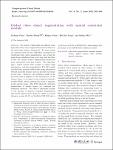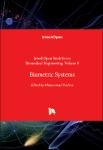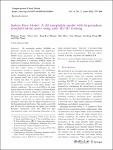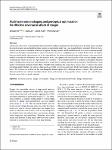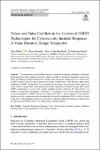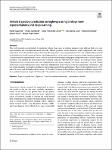Search
Author
- Jorgensen, Ed (3)
- McFadyen, Ron (3)
- Nora, El-Rashidy (3)
- Christian, Homeyer (2)
- next >
Subject
- programming (10)
- Open Access (8)
- Java (7)
- Programming (7)
- next >
Date issued
- 2020 - 2025 (293)
- 2010 - 2019 (39)
- 2000 - 2009 (2)
- 1999 - 1999 (1)
Has File(s)
- true (335)
Search Results
We present a lightweight and efficient semi-supervised video object segmentation network based on the space-time memory framework. To some extent, our method solves the two difficulties encountered in traditional video object segmentation: one is that the single frame calculation time is too long, and the other is that the current frame’s segmentation should use more information from past frames. The algorithm uses a global context (GC) module to achieve high-performance, real-time segmentation. |
A biometric system is a technological system that uses information about a person or other biological organism to identify that person. The biometric industry is rapidly changing and progressing at an astonishing speed. The main objective of this book is to provide the international community with an effective platform in the area of people identity verification and authentication from physiological and behavioral aspects. The book is also targeted to describe the latest emerging settings and requirements in biometric systems and technologies. |
In this manuscript, we present a common tensor framework which can be used to generalize one-dimensional numerical tasks to arbitrary dimension d by means of tensor product formulas. This is useful, for example, in the context of multivariate interpolation, multidimensional function approximation using pseudospectral expansions and solution of stiff differential equations on tensor product domains. The key point to obtain an efficient-to-implement BLAS formulation consists in the suitable usage of the μ-mode product (also known as tensor-matrix product or mode-n product) and related operations, such as the Tucker operator. Their MathWorks MATLAB®/GNU Octave implementations are discussed in the paper, and collected in the package KronPACK. |
3D morphable models (3DMMs) are generative models for face shape and appearance. Recent works impose face recognition constraints on 3DMM shape parameters so that the face shapes of the same person remain consistent. However, the shape parameters of traditional 3DMMs satisfy the multivariate Gaussian distribution. In contrast, the identity embeddings meet the hypersphere distribution, and this conflict makes it challenging for face reconstruction models to preserve the faithfulness and the shape consistency simultaneously. |
Adversarial attack aims to fail the deep neural network by adding a small amount of perturbation to the input image, in which the attack success rate and resulting image quality are maximized under the lp norm perturbation constraint. However, the lp norm is not accurately correlated to human perception of image quality. Attack methods based on l0 norm constraint usually suffer from the high computational cost due to the iterative search for candidate pixels to modify. |
Algebraically stabilized finite element discretizations of scalar steady-state convection–diffusion–reaction equations often provide accurate approximate solutions satisfying the discrete maximum principle (DMP). However, it was observed that a deterioration of the accuracy and convergence rates may occur for some problems if meshes without local symmetries are used. The paper investigates these phenomena both numerically and analytically and the findings are used to design a new algebraic stabilization called Symmetrized Monotone Upwind-type Algebraically Stabilized (SMUAS) method. It is proved that the SMUAS method is linearity preserving and satisfies the DMP on arbitrary simplicial meshes. Moreover, numerical results indicate that the SMUAS method leads to optimal convergence ra... |
Next, the RGB channels of the watermark are encrypted by using Arnold, 3-DES and multi-flipping permutation encoding (MFPE). Furthermore, the principal key used for encryption is embedded in the singular matrix of the blue channel. Moreover, the blue channel is encrypted by using the Okamoto-Uchiyama homomorphic encryption (OUHE) method. Finally, these encrypted watermark channels are diffused and embedded into the host channels. When the need arises, more watermarks can be embedded into the host at the expense of the quality of the embedded watermarks. |
The negotiation of stakeholder values as a collaborative process throughout technology development has been studied extensively within the fields of Computer Supported Cooperative Work and Human-Computer Interaction. Despite their increasing significance for cybersecurity incident response, there is a gap in research on values of importance to the design of open-source intelligence (OSINT) technologies for this purpose. In this paper, we investigate which values and value conflicts emerge due to the application and development of machine learning (ML) based OSINT technologies to assist cyber security incident response operators. |
This work presents a novel method for predicting vehicle trajectories in highway scenarios using efficient bird’s eye view representations and convolutional neural networks. Vehicle positions, motion histories, road configuration, and vehicle interactions are easily included in the prediction model using basic visual representations. The U-net model has been selected as the prediction kernel to generate future visual representations of the scene using an image-to-image regression approach. |
This paper explores the relationship between an author's position in the bylines of an article and the research contributions they have made to analyze the validity of five bibliometric counting methods (arithmetic, fractional, geometric, harmonic, and harmonic parabolic author credit allocation) in the field of Chemical Biology. By classifying the tasks found in the author contribution statements of articles published in Nature Chemical Biology according to a three-tiered scheme, it was possible to divide the authors into three types: core-layer authors, middle-layer authors, and outer-layer authors. |

